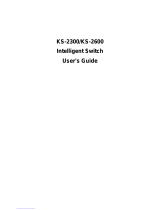
N8406-023 1Gb Intelligent L3 Switch Application Guide 4
Multiple VLANS with tagging ................................................................................................................................ 49
Configuring the example network .................................................................................................................... 50
FDB static entries ................................................................................................................................................. 57
Trunking support for FDB static entries ........................................................................................................... 57
Configuring a static FDB entry ........................................................................................................................ 57
Spanning Tree Protocol
Introduction ........................................................................................................................................................... 58
Overview ............................................................................................................................................................... 58
Bridge Protocol Data Units ................................................................................................................................... 58
Determining the path for forwarding BPDUs ................................................................................................... 58
Spanning Tree Group configuration guidelines .................................................................................................... 59
Default Spanning Tree configuration ............................................................................................................... 59
Adding a VLAN to a Spanning Tree Group ..................................................................................................... 59
Creating a VLAN ............................................................................................................................................. 59
Rules for VLAN tagged ports .......................................................................................................................... 59
Adding and removing ports from STGs ........................................................................................................... 60
Assigning cost to ports and trunk groups ........................................................................................................ 60
Multiple Spanning Trees ....................................................................................................................................... 60
Why do we need Multiple Spanning Trees? .................................................................................................... 60
VLAN participation in Spanning Tree Groups ................................................................................................. 61
Configuring Multiple Spanning Tree Groups ................................................................................................... 61
Port Fast Forwarding ............................................................................................................................................ 63
Configuring Port Fast Forwarding ................................................................................................................... 64
Fast Uplink Convergence ..................................................................................................................................... 64
Configuration guidelines .................................................................................................................................. 64
Configuring Fast Uplink Convergence ............................................................................................................ 64
RSTP and MSTP
Introduction ........................................................................................................................................................... 65
Rapid Spanning Tree Protocol ............................................................................................................................. 65
Port state changes .......................................................................................................................................... 65
Port type and link type ..................................................................................................................................... 65
RSTP configuration guidelines ........................................................................................................................ 66
RSTP configuration example .......................................................................................................................... 66
Multiple Spanning Tree Protocol .......................................................................................................................... 68
MSTP region ................................................................................................................................................... 68
Common Internal Spanning Tree .................................................................................................................... 68
MSTP configuration guidelines ....................................................................................................................... 68
MSTP configuration example .......................................................................................................................... 68
Quality of Service
Introduction ........................................................................................................................................................... 73
Overview ............................................................................................................................................................... 73
Using ACL filters ................................................................................................................................................... 74
Summary of packet classifiers ........................................................................................................................ 74
Summary of ACL actions ................................................................................................................................ 75
Understanding ACL precedence ..................................................................................................................... 75
Using ACL Groups ................................................................................................................................................ 77
ACL Metering and Re-marking ............................................................................................................................. 77
Metering .......................................................................................................................................................... 77
Re-marking ...................................................................................................................................................... 78
Viewing ACL statistics .......................................................................................................................................... 78
ACL configuration examples ................................................................................................................................. 78
Configure Access Control Lists (AOS CLI example) ....................................................................................... 78
Configure Access Control Lists and Groups (BBI example 1) ........................................................................ 79
Using DSCP values to provide QoS ..................................................................................................................... 83
Differentiated Services concepts..................................................................................................................... 83
Per Hop Behavior ............................................................................................................................................ 83
QoS levels ....................................................................................................................................................... 84
Using 802.1p priorities to provide QoS ................................................................................................................. 84
802.1p configuration (AOS CLI example) ....................................................................................................... 85
802.1p configuration (BBI example) ................................................................................................................ 86
Queuing and scheduling ....................................................................................................................................... 89
Basic IP routing
IP routing benefits ................................................................................................................................................. 90





















